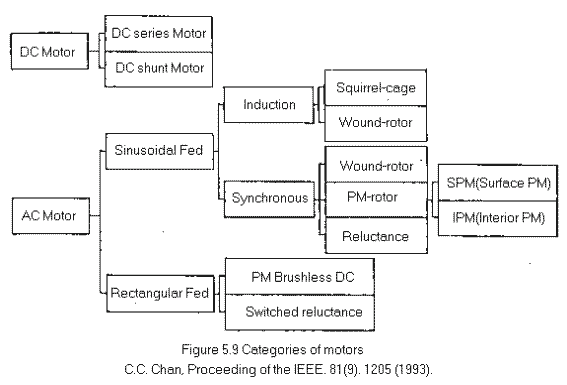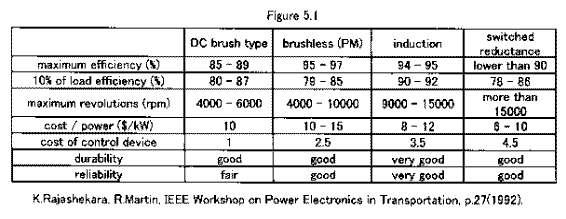|
Motor for electric vehicles
The motors used in electric vehicles should be powerful
enough to satisfy the traction requirements to meet the vehicle
performance and the other requirements.
1. Small and lightweight for the vehicle layout. 2. High efficiency
to convert energy from electricity to traction and save fuel or
electricity. 3. Durable and easy to maintain. Must be able to be
used under various conditions in vehicles, such as vibration, variable
temperatures and humidity. 4. Low noise. 5.Low cost. This last point
is to encourage the widespread use.
Figure 5.1 shows the requirements of vehicle traction.
DC motors were used in early electric vehicles for 2 reasons: their
torque and power characteristics, which meet these requirements.
Speed can easily be controlled when these motors are used. But in
the 90s AC motors became dominant as progress in self-switching
devices was made, such as IGBT(insulated gate bipolar transistor)
which enables high-power inverters to be put to industrial use.
The device in DC motors that controls the speed does not have an
inverter, but the brush and commutator require periodic maintenance.
And it is difficult to downsize by mechanically. DC motors will
be used in a few vehicles, like electric golf carts. AC motors will
be the main support of progress in electric vehicles from now on.
Categories of motors
There are various categories and names for motors. Figure
5.9 shows one of them for electric vehicles. In this figure, AC
motors are categorized according to the electric current wave shape
into 2 classes, sinusoidal and 'others'. As this reference figure
is only for AC motors, the category of DC motors has been added.
Currently, the focus of development of motors for electric vehicles
is moving from DC motors to AC motors. The most popular AC motors
are the squirrel-cage type induction motor and the PM motor, which
uses a permanent magnet in its rotor.
In Fig. 5.9, a brushless DC motors is categorized as non-signusoidal.
This motor consists of a permanent magnet in the rotor and a wound
stator, the same as a PM motor. This type is called DC brushless
to exchange the actuating elements of brush and ommutatorc of DC
motor by switching devices such as transistors. It came from the
servomotor.
Usually, the PM motor is driven by sinusoidal current according
to the rotor location, and the DC brushless motor driven by a trapezoidal
or rectangular current. The wave shape of the driving current in
these two motors differs from that of the inverters. But they have
the same structure. In this handbook, we call them PM motors.


Reference
Book title: EV Handbook
Written by: EV Handbook Publisher's Group
Published by: Maruzen Co., Ltd. (URL http://www.maruzen.co.jp)
|